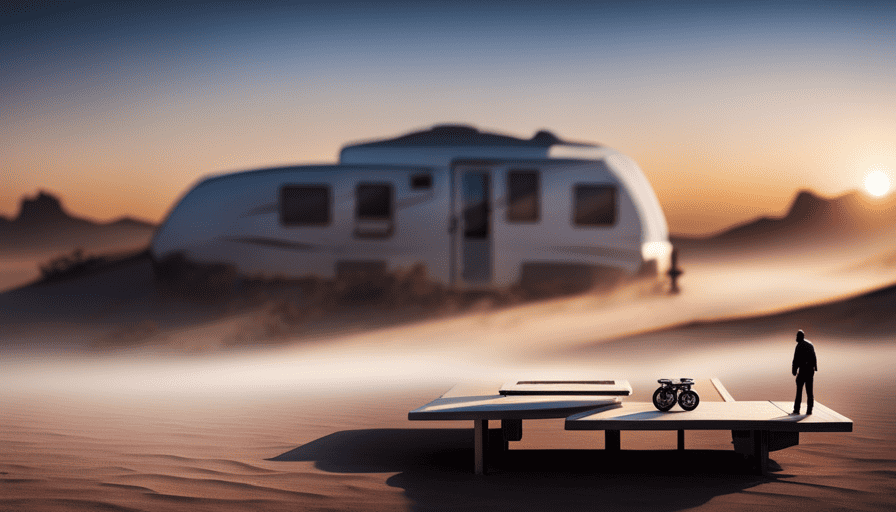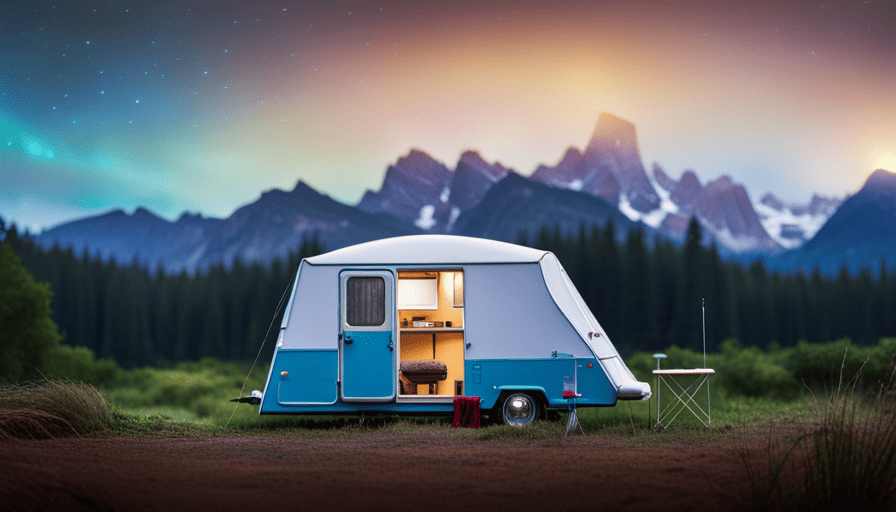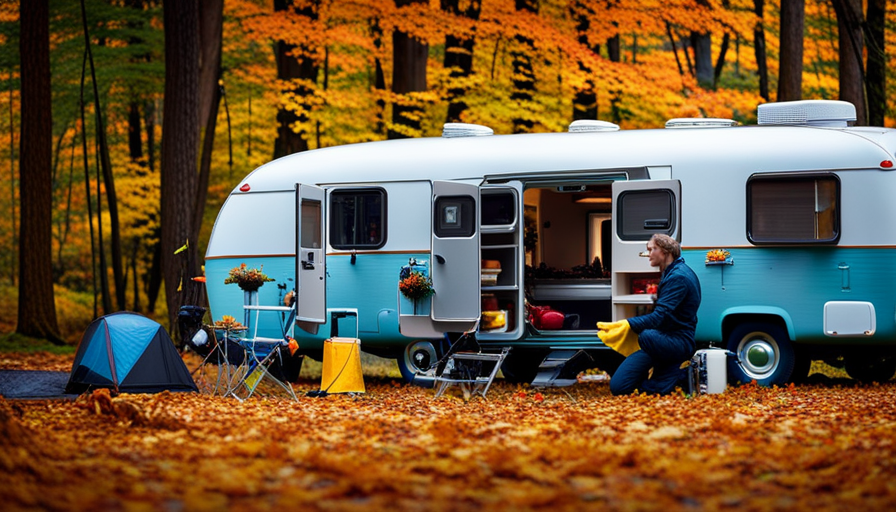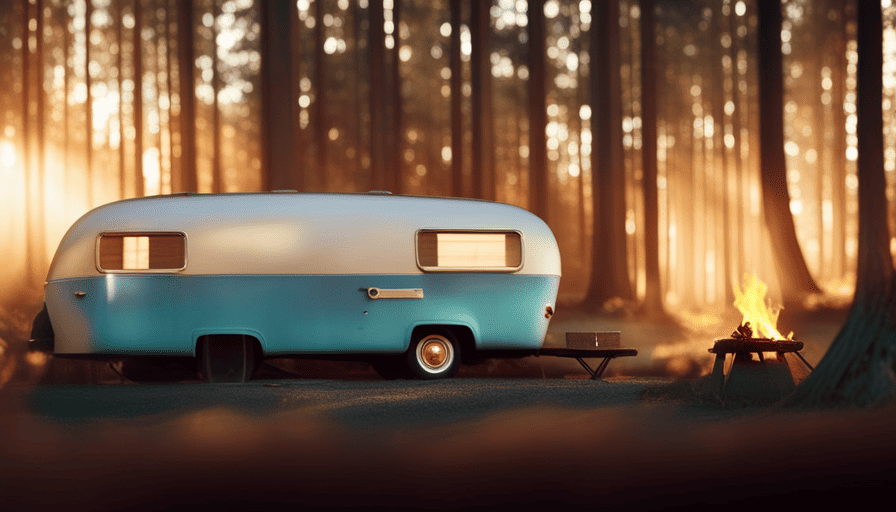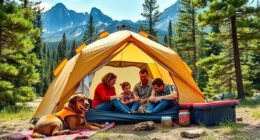Picture this: you’re basking in a warm summer evening, the sun setting below the horizon, surrounded by your family and friends around a crackling campfire. The scent of fresh coffee fills the air, laughter echoing through the trees. The one thing missing? Your own camper trailer.
Building a camper trailer can be an incredibly rewarding project, allowing you to create a personalized space that brings the comforts of home wherever your adventures take you. With a little know-how and some elbow grease, you can turn an ordinary trailer base into a cozy and functional home on wheels.
In this article, I will guide you through the step-by-step process of creating your own camper trailer. From choosing the right trailer base to adding the finishing touches, I will share my knowledge and experience to help you bring your dream camper trailer to life.
So grab your tools and let’s get started on this exciting journey together!
Key Takeaways
- Choose the right trailer base by considering weight, size, and consulting experts.
- Use high-quality materials and tools for construction and sealing.
- Maximize space and consider multifunctional furniture for the interior layout.
- Plan carefully for electrical and plumbing systems, including off-grid power options.
Choose the Right Trailer Base
Choosing the right trailer base will make you feel like you’ve found the perfect match for your dream camper. When it comes to selecting a trailer base, two key factors to consider are the trailer weight and trailer size.
The trailer weight is crucial because it determines the towing capacity of your vehicle and affects fuel efficiency on the road. You don’t want a trailer that is too heavy for your vehicle to handle comfortably.
On the other hand, the trailer size plays a vital role in the overall design and layout of your camper. It determines how much space you will have for living, sleeping, and storage. It’s essential to choose a size that fits your needs and preferences.
Before making a decision, I recommend researching different trailer bases and consulting with experts in the field. They can provide valuable insights and help you find the perfect trailer base for your camper.
Once you have chosen the right trailer base, you can move on to the exciting next step of designing your floor plan. This is where you can unleash your creativity and personalize your camper to suit your lifestyle and preferences.
So, let’s dive into the next section and explore how to design your dream camper’s floor plan.
Design Your Floor Plan
Decide on the layout of your floor plan, ensuring it reflects your vision and brings your dream camper trailer to life. The floor plan is the foundation of your camper trailer design, so it’s important to take the time to create a layout that meets your needs and maximizes space.
Here are four floor plan tips to consider:
-
Functionality: Think about how you’ll use your camper trailer and plan your layout accordingly. Consider the placement of essential features like the kitchen, bathroom, sleeping area, and storage space.
-
Space Optimization: Make the most of the available space by utilizing clever storage solutions and multifunctional furniture. Think about incorporating foldable tables and beds, as well as utilizing vertical storage options.
-
Natural Light: Incorporate large windows or skylights in your floor plan to maximize natural light inside the camper trailer. This not only makes the space feel more open and airy but also reduces the need for artificial lighting during the day.
-
Design Inspiration: Look for design inspiration from camper trailer magazines, websites, and social media platforms. Take note of layouts that catch your eye and incorporate elements that inspire you into your own floor plan.
Once you’ve finalized your floor plan, it’s time to gather the materials and tools you’ll need to bring your camper trailer to life.
Gather Materials and Tools
Get ready to embark on an exciting adventure as you gather all the materials and tools you’ll need to bring your dream of a personalized and cozy home on wheels to life.
When it comes to choosing the right trailer base for your camper, it’s important to consider factors like size, weight capacity, and durability. Look for a trailer that can accommodate your desired floor plan and has the necessary features, such as a sturdy frame and suspension system.
Once you have selected the perfect trailer, it’s time to start designing the floor plan. Think about how you want to utilize the space and what amenities you want to include. Consider the layout of your kitchen, bathroom, sleeping area, and storage space. Don’t forget to account for electrical and plumbing needs as well.
As you gather materials and tools, make sure to invest in high-quality items that will withstand the rigors of the road. You’ll need tools like a drill, saw, measuring tape, and various hand tools. Additionally, you’ll need materials such as lumber, insulation, wiring, plumbing fixtures, and flooring.
With all your materials and tools in hand, you’re now ready to move on to the next step: building the frame and walls of your camper.
Transitioning seamlessly into this section, let’s begin constructing the foundation of your dream camper.
Build the Frame and Walls
As you embark on the construction of your dream home on wheels, the foundation of your adventure awaits. The frame and walls symbolize the sturdy backbone and protective shell that will bring your vision to life.
When it comes to building the frame and walls of your camper trailer, there are a few key considerations to keep in mind. Firstly, you’ll want to decide on the type of insulation you’ll use. There are a variety of options available, including foam insulation boards, reflective insulation, and spray foam insulation. Each option has its own benefits and drawbacks, so it’s important to research and choose the one that best suits your needs.
In terms of wall construction techniques, you have a few choices as well. One popular method is using wooden studs and plywood panels to create a sturdy and secure structure. Another option is using aluminum or steel framing, which offers durability and strength. Whichever method you choose, it’s important to ensure that the walls are properly sealed and reinforced to prevent any leaks or damage.
With the frame and walls in place, it’s time to move on to the next step: installing windows and doors. This will allow you to bring in natural light, provide ventilation, and create easy access to your camper trailer. So, let’s dive into the exciting process of transforming your dream into reality by adding these essential elements to your home on wheels.
Install Windows and Doors
Once the frame and walls are secure, it’s time to bring in natural light and create easy access to your dream home on wheels by installing windows and doors.
Window installation is a crucial step in the camper trailer construction process. Not only do windows provide ventilation and a source of natural light, but they also offer stunning views of the great outdoors. When choosing windows, opt for ones that are durable, weather-resistant, and easy to clean. Make sure to measure accurately and cut the openings in the walls accordingly. Secure the windows firmly using screws and seal them properly to prevent any leaks.
Door installation is another important aspect of building a camper trailer. The door not only provides access to the interior but also acts as a barrier between the outside elements and the cozy living space. Choose a sturdy and secure door that fits the overall aesthetic of your camper trailer. Install the door using hinges and make sure it opens and closes smoothly. Don’t forget to add a durable lock for added security.
- Choose windows that are durable, weather-resistant, and easy to clean.nn2. Measure accurately and cut openings in the walls accordingly.nn3. Secure windows firmly using screws and seal them properly to prevent leaks.nn4. Install a sturdy and secure door that fits the overall aesthetic of your camper trailer.
Now that the windows and doors are in place, it’s time to move on to creating the interior layout of your camper trailer.
Create the Interior Layout
After the windows and doors have been installed, it’s time to unleash your creativity and design the interior layout of your cozy home on wheels. Maximizing space is crucial in a camper trailer, as every inch counts. Think about multifunctional furniture that can serve multiple purposes. For example, a sofa that can be converted into a bed or a table that can be folded down when not in use. This way, you can make the most out of the limited space available.
Choosing the right furniture is also important. Opt for lightweight and compact pieces that are easy to move around and store. Consider using modular furniture that can be rearranged to adapt to your changing needs. Additionally, incorporating storage solutions such as overhead cabinets, under-bed compartments, and hanging organizers can help keep your belongings organized and maximize the available space.
To help you visualize the possibilities, here is a 2 column and 3 row table showcasing different furniture options and their potential uses:
| Furniture | Potential Use |
|---|---|
| Futon | Sofa by day, bed by night |
| Folding table | Dining table or workspace |
| Murphy bed | Bed that can be folded up against the wall when not in use |
| Ottoman with storage | Extra seating and hidden storage |
| Wall-mounted shelves | Display items or store books |
| Collapsible chairs | Additional seating for guests |
By thoughtfully designing the interior layout and selecting the right furniture, you can create a functional and comfortable living space within your camper trailer. Now, let’s move on to the exciting task of installing the electrical and plumbing systems.
Install Electrical and Plumbing Systems
To create a truly functional and comfortable living space, it’s essential to install the electrical and plumbing systems in your cozy home on wheels.
The electrical system installation tips I can offer are based on my personal experience and knowledge. Firstly, make sure to plan your electrical layout carefully, considering the power requirements of all your appliances and devices. Use multiple circuit breakers to avoid overloading any one circuit. Additionally, invest in high-quality wiring and connectors to ensure a reliable and safe electrical system. Don’t forget to install a battery bank and a solar panel system to provide off-grid power when needed.
When it comes to the plumbing system, troubleshooting can be a common issue. One tip is to always check for leaks before closing up the walls. Use PEX tubing for water supply lines, as it’s flexible, durable, and resistant to freezing. For wastewater, consider installing a gray water tank to collect and dispose of it responsibly. Another important aspect is the water pump. Choose a quiet and efficient pump that can handle the water demand of your camper.
With the electrical and plumbing systems in place, it’s time to move on to the next step of adding insulation and flooring to create a cozy and comfortable space for your adventures.
Add Insulation and Flooring
Enhance the comfort and coziness of your mobile home by adding insulation and flooring that’ll keep you warm during chilly nights and provide a solid foundation for your adventures.
When it comes to insulation, there are a few different types to consider. One option is fiberglass insulation, which is easy to install and provides excellent thermal resistance. Another option is foam board insulation, which offers superior insulation properties and can help reduce noise. Additionally, spray foam insulation is a popular choice as it expands to fill every nook and cranny, creating an airtight seal and preventing heat loss.
Moving on to flooring options, there are several materials to choose from. One of the most popular choices is laminate flooring, which is durable, easy to clean, and available in a variety of styles. Another option is vinyl flooring, which is waterproof and perfect for areas prone to moisture. Additionally, hardwood flooring adds a touch of elegance to your camper trailer, but it may require more maintenance.
By adding insulation and choosing the right flooring, you can create a comfortable and inviting living space in your camper trailer.
Once you’ve completed this step, you can move on to building cabinets and storage spaces, ensuring that everything has its place and maximizing the use of your limited space.
Build Cabinets and Storage Spaces
Maximize the functionality of your mobile home by building cabinets and storage spaces that will keep your belongings organized and easily accessible. When it comes to camper trailers, every inch of space counts, so it’s crucial to make the most out of your storage options.
By building customized cabinets and storage spaces, you can effectively maximize storage while also keeping your belongings organized and secure. One way to maximize storage is by utilizing vertical space. Install overhead cabinets above the kitchen area and along the walls to store items that are not frequently used. This will free up valuable counter space and keep your cooking essentials within reach.
Additionally, consider adding drawers underneath the bed or seating areas. These drawers can be used to store clothes, bedding, or any other items that need to be readily accessible. Organizing belongings is another important aspect of building cabinets and storage spaces. Use dividers or bins to separate and categorize items, making it easier to find what you need.
Install hooks or racks on the walls to hang jackets, hats, or keys. Utilize small baskets or containers to keep smaller items like toiletries or cooking utensils organized. By maximizing storage and organizing belongings, your camper trailer will become a clutter-free and functional space.
With everything in its designated place, you’ll be able to enjoy your travels without the frustration of searching for misplaced items. In the next section, we’ll explore how to add finishing touches and decorations that will personalize your mobile home and make it truly feel like your own.
Add Finishing Touches and Decorations
Spruce up your mobile home and make it truly feel like your own by adding the perfect finishing touches and decorations. When it comes to choosing colors for your camper trailer, it’s important to consider the overall theme and atmosphere you want to create.
Earthy tones like beige, brown, and green can give your space a cozy and natural feel, while brighter colors like yellow or blue can add a pop of vibrancy. Personally, I’ve found that a combination of neutral and bold colors can create a balanced and inviting space.
Once you’ve decided on the color scheme, it’s time to select furniture that not only fits your style but also maximizes the limited space in your camper. Opt for multipurpose furniture that can serve multiple functions, such as a sofa that can also be converted into a bed or a table that can be folded and stored away when not in use. Additionally, consider lightweight and compact furniture that is easy to move around and doesn’t take up too much space.
To add the finishing touches, incorporate decorations that reflect your personality and interests. Hang artwork or photographs on the walls, add cozy throw pillows and blankets to the seating area, and display small trinkets or souvenirs on shelves or countertops. Don’t be afraid to get creative and make your camper trailer truly feel like home.
Frequently Asked Questions
How much does it cost to build a camper trailer?
Building a camper trailer can be an exciting and rewarding project, but it’s important to carefully consider your budget.
The cost of building a camper trailer can vary greatly depending on factors such as materials, size, and features. A budget-friendly approach is to research and source materials at affordable prices, repurpose items when possible, and prioritize essential features.
Creating a cost breakdown and sticking to it will ensure that you can build a camper trailer within your means while still enjoying the process.
Can I use any type of trailer base for my camper trailer?
Sure, you can use various types of trailer bases for your camper trailer, depending on your needs and preferences. There are standard utility trailers, flatbed trailers, and even horse trailers that can be customized to fit your camping requirements.
The pros of using a different trailer base include cost-effectiveness and the ability to customize the interior layout. However, it’s important to consider the cons such as limited space and potential modifications needed for proper insulation and amenities.
What are the basic tools and materials needed to build a camper trailer?
To build a camper trailer, you’ll need a range of tools and materials. Some essential tools include a circular saw, drill, tape measure, and screwdriver set.
As for materials, you’ll need plywood for the trailer base, insulation for the walls, and aluminum sheets for the exterior. Other materials such as screws, hinges, and electrical wiring will also be necessary.
The construction process involves cutting and assembling the base, framing the walls, installing windows and doors, and adding the finishing touches.
How long does it typically take to build a camper trailer?
Building a camper trailer is a labor of love that requires time, patience, and skill. The building timeline can vary depending on the complexity of the design and your level of experience. Generally, it takes several months to complete a camper trailer from start to finish.
However, this timeline can be affected by common challenges, such as sourcing materials, weather conditions, and unexpected setbacks. Despite these challenges, the end result is always worth the effort.
Are there any legal requirements or permits needed to build and use a camper trailer?
Yes, there are legal requirements and permits needed to build and use a camper trailer. These include obtaining construction permits and complying with local ordinances and regulations.
It’s important to research and understand the specific requirements in your area before starting the construction process. Failure to obtain the necessary permits could result in fines or other legal consequences.
It’s always best to ensure that your camper trailer is built and used in compliance with all applicable laws and regulations.
What Are the Similarities Between Making a Camper Van and Making a Camper Trailer?
When it comes to building a mobile home, the similarities between making a camper van and making a camper trailer are abundant. Both processes involve carefully selecting materials, creating a functional living space, and incorporating essential amenities. From the initial design to the installation of plumbing and electrical systems, the steps to make a camper van and a camper trailer align in many ways.
Conclusion
In conclusion, building your own camper trailer is a rewarding and fulfilling project that allows you to create your own personalized home on wheels.
While it may seem daunting at first, with the right planning, tools, and materials, anyone can accomplish this feat.
Some may argue that it’s more convenient and cost-effective to buy a pre-made camper trailer, but the satisfaction and sense of accomplishment that comes with building your own can’t be matched.
So why wait? Start your camper trailer journey today and create memories that’ll last a lifetime.


